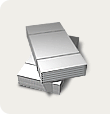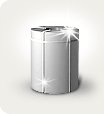The coating of metal products with a relatively thin layer of other metals (both more and less active in relation to the base metal /alloy) has been a long and very widespread industrial practice. In relation to steel /iron, zinc is more electrochemically active, therefore coatings based on it belong to the first type, and the application process itself is often called "galvanizing" or "galvanizing" (sometimes you can also find the "hybrid" term " metal galvanizing " - but it is not quite literate, it is better not to use it at all). The purpose of the coating being formed is to protect the product from corrosion, thereby extending its service life tenfold and, at the same time, reducing the cost of its preventive inspections /maintenance.
The existing methods of galvanizing are usually divided into hot and cold. In the latter case, either a zinc layer of the required thickness is deposited on the previously cleaned and degreased surface of the product from a special solution by the action of an electric current, or finely dispersed zinc powder in the form of a paste with a polymer binder is mechanically applied to the surface to be protected (zinc itself in such a paste should be more than 80%, since otherwise the proper protective effect will not be obtained). The electrolytic method also has its drawbacks: it is time-consuming, technically difficult, rather "capricious" in relation to the shape of the product and its total surface area - that is, it is far from always possible to obtain a strong and uniform coating that is not prone to flaking.
The principle of hot-dip galvanizing is different: in a special heated bath, metal zinc is first melted in the required amount (this is not particularly difficult, since zinc has a relatively low melting point, about 420 ° C - in comparison, such a widely used metal as lead melts at about 330 ° C ). Then, objects chemically cleaned from oxides on the surface are pulled (or dipped into it) through a bath with liquid zinc - and liquid zinc independently covers the entire submerged surface as easily and simply as when soldering with a soldering iron, lead-tin solder spreads over the surface of a tinned copper wire. After removing the object from the bath, the excess still liquid zinc can be quickly removed mechanically (for example, "shaken off") - and the coating is ready! It is important to note that the productivity of hot-dip galvanizing is several orders of magnitude higher than that of cold-galvanizing - therefore, industrial protection of large metal structures is usually done in a hot way.
Briefly about hot and cold galvanizing

|
|
Azovpromstal® 27 July 2017 г. 19:36 |
Subscribe to news 
Metallurgy news
- Today
17:00 Exports of reinforcement from the United States in August 2025 decreased by 44.2 percent 17:00 Imports of linear pipes to the United States increased by 1.3 percent in August 2025 16:00 Import of steel bars to Georgia from Turkey to increase in January-November 2025 16:00 South Africa launches AD investigation into color-coated steel from China 15:00 Australia issues final AD margin on rebar from four countries, including Turkey 15:00 GEM: Decarbonization of blast furnaces remains a key area of transition for the global steel industry 14:00 German steel production fell by 9.3% in January-November 2025, with the sector demanding swift action to protect production 14:00 Kardemir from Turkey appointed a new general manager
Publications
22.12 21.12 Shelving racks from Fortis Stroy 19.12 Materials for construction and repair of life: current solutions 15.12 Ägyptens Schätze: Die Magie von Kairo und Hurghada Entdecken 15.12 Best entertainment for children in Almaty: Top 5 places to go





